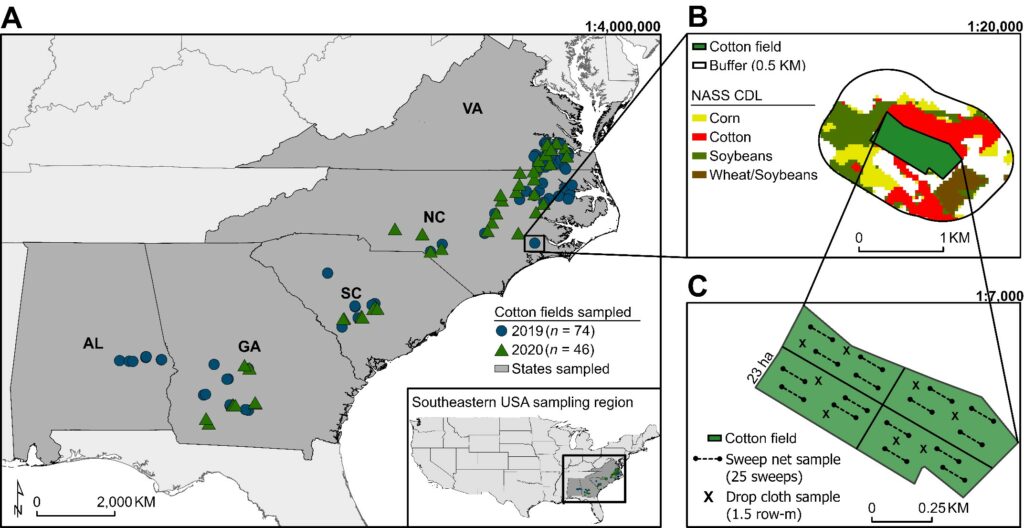Sampling Plans for Plant Bugs – Challenges of Monitoring Aggregated Pest Populations
go.ncsu.edu/readext?869374
en Español / em Português
El inglés es el idioma de control de esta página. En la medida en que haya algún conflicto entre la traducción al inglés y la traducción, el inglés prevalece.
Al hacer clic en el enlace de traducción se activa un servicio de traducción gratuito para convertir la página al español. Al igual que con cualquier traducción por Internet, la conversión no es sensible al contexto y puede que no traduzca el texto en su significado original. NC State Extension no garantiza la exactitud del texto traducido. Por favor, tenga en cuenta que algunas aplicaciones y/o servicios pueden no funcionar como se espera cuando se traducen.
Português
Inglês é o idioma de controle desta página. Na medida que haja algum conflito entre o texto original em Inglês e a tradução, o Inglês prevalece.
Ao clicar no link de tradução, um serviço gratuito de tradução será ativado para converter a página para o Português. Como em qualquer tradução pela internet, a conversão não é sensivel ao contexto e pode não ocorrer a tradução para o significado orginal. O serviço de Extensão da Carolina do Norte (NC State Extension) não garante a exatidão do texto traduzido. Por favor, observe que algumas funções ou serviços podem não funcionar como esperado após a tradução.
English
English is the controlling language of this page. To the extent there is any conflict between the English text and the translation, English controls.
Clicking on the translation link activates a free translation service to convert the page to Spanish. As with any Internet translation, the conversion is not context-sensitive and may not translate the text to its original meaning. NC State Extension does not guarantee the accuracy of the translated text. Please note that some applications and/or services may not function as expected when translated.
Collapse ▲As we move toward squaring and bloom stages, it is essential to plan plant bug scouting strategies depending on crop development. Our recommended thresholds for squaring and bloom-stage cotton provide a recommended number of stops per field (scouting information can be found on the Tarnished Plant Bugs Article).
In that recommendation, we highlight the tendency of adult plant bugs to aggregate in pockets along field edges. These field-scale recommendations work well, but there is still some uncertainty about the similarity among fields and which land-use factors are related to higher plant bug numbers.
To tackle this problem cotton entomologists surveyed 120 fields across the southeastern USA. We sampled cotton at square and again at bloom at four locations within each field (Fig. 1).

Figure 1. (A) 120 commercial cotton fields sampled across the southeastern USA in 2019 and 2020. (B) Land use information around fields. (C) Four 25 sweep net sampling units and two drop cloth (1.5 row-m) units per quadrant for sweep net and drop cloth sampling, respectively (figure from Dorman et al. 2022).
Key Findings:
- We found that plant bugs counts were most variable with and among fields. In other words, we found many instances of high and low counts within individual fields. In addition, fields in a given area had very different levels of pressure.
- This finding tells us that thorough scouting is necessary 1) across the field, and 2) among fields in a growing area.
- The amount of double-cropped wheat/soybean and the total amount of ag land surrounding our cotton fields was the best predictor of plant bug counts.
- We found that more sweep samples & drops improved our estimate of plant bug populations.
What do these results mean for plant bug scouting in 2022?
- Assuming a single field is representative of cotton on a farm or region is not a good idea
- We have a significant amount of double-crop wheat/beans in some cotton growing areas. Ensure susceptible cotton near grain is scouted thoroughly.
- Take enough samples. We recommend 6-10 per field. Ensure these samples are distributed across the field to minimize chances of missing a pocket of plant bugs.
We thank all the researchers that contributed to this work. The full paper can be found on MDPI.


